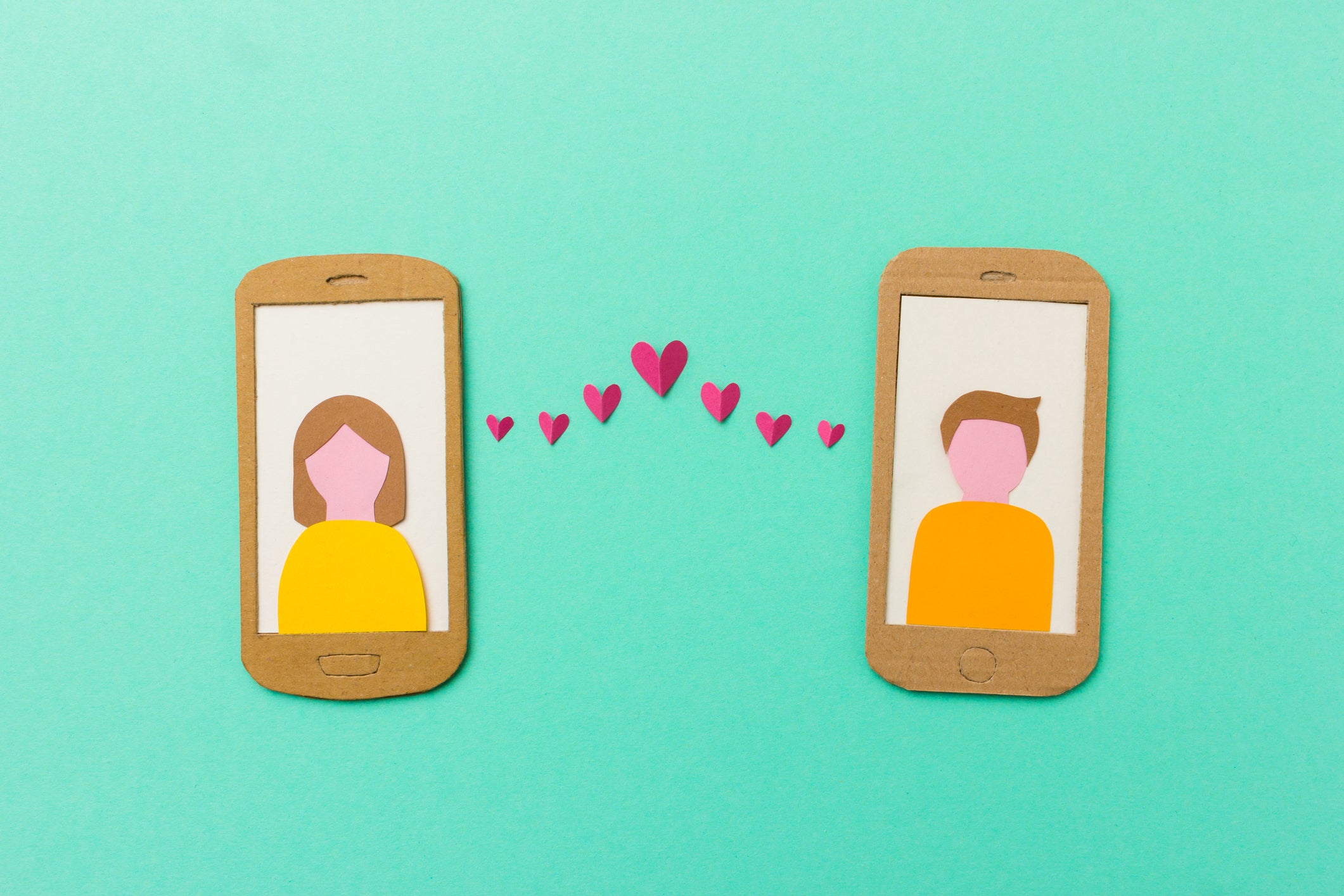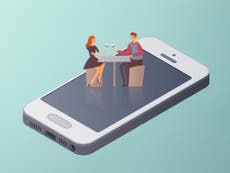Finding love in a pandemic is tough – even as a dating app researcher
Video calling can be entertaining, but there is certainly a vast gap between it and an in-person date

Your support helps us to tell the story
From reproductive rights to climate change to Big Tech, The Independent is on the ground when the story is developing. Whether it's investigating the financials of Elon Musk's pro-Trump PAC or producing our latest documentary, 'The A Word', which shines a light on the American women fighting for reproductive rights, we know how important it is to parse out the facts from the messaging.
At such a critical moment in US history, we need reporters on the ground. Your donation allows us to keep sending journalists to speak to both sides of the story.
The Independent is trusted by Americans across the entire political spectrum. And unlike many other quality news outlets, we choose not to lock Americans out of our reporting and analysis with paywalls. We believe quality journalism should be available to everyone, paid for by those who can afford it.
Your support makes all the difference.Ask someone to list romantic ways of meeting a partner and you’ll likely hear a variation of the same set of answers: locking eyes with a stranger across a crowded bar; smiling at someone on the Tube, hoping they’ll work up the courage to speak to you; falling in love after months of working late shifts together at the office. Meeting on a dating app is unlikely to feature.
I have spent the past two years researching dating apps and dating culture, and I think this is partly due to a nostalgic aversion to new media in the domain of intimacy – nobody really wants to credit an app, or worse, an algorithm, for their latest tryst. Most of us remain in pursuit of that elusive Hollywood “meet cute”.
One phrase has cropped up consistently when I’ve spoken to both users and non-users of dating technology – that meeting someone on a dating app is different to “real life”. Yet, technology has historically always played a prominent role in dating rituals. From grandiloquent love letters, to hushed late-night phone calls, or tentative advances via email; many of our most intimate interactions have been mediated in one form or another.
Today, it is often through WhatsApp that much of the courting, romance (and even, occasionally, sex) between partners occurs; message threads providing an archive of past relationships and intimate encounters. These online interactions – the elation, hurt, seduction and tears – enacted through smartphones and other devices, are very much part of “real life”.
The pandemic has heightened the significance of these online encounters all the more, with most of our daily intimacies to be found in the glowing rectangles of video calls and social media. At least, this has been the case for me; having spent last year’s lockdown in a long-distance relationship between Berlin and London: an uncanny montage of falling asleep on FaceTime and laptops placed at dinner tables, instead of the person who should be there in the flesh.
During the current Covid-19 lockdown I find myself, somewhat less glamorously, back in my childhood bedroom in Essex – single, and with a PhD thesis to write.
With little else to do until restrictions ease, I decided to try out the latest lockdown trend: video dating. In Berlin, where I conducted some of my fieldwork during the pandemic, very few people seemed interested in video dating; choosing to either go for walks or forego social distancing altogether.
For those that did try dating through a video call, experiences were middling at best – it’s easy for a Zoom call with a stranger to feel like a work meeting after a day of work meetings in the form of Zoom calls with strangers.
For my first video date, I matched with Jane* through Hinge, the algorithm of which knows me so well that nearly every profile I see looks like someone I’d get on with. This shouldn’t come as a surprise, since Hinge, like other dating apps, guzzles every piece of data that it can sink its teeth into, even things like how long it takes you to ask for a match’s number. Most dating apps employ some form of collaborative filtering.
Even if you haven’t heard of this term, you’ve definitely experienced it. It’s what happens when you buy a golf club and Amazon suggests that you buy a certain brand of golf ball, or when Netflix tells you what to watch next. To put it very simply, the idea is that if you buy the same product as someone else, you might also want the other things in their shopping basket. “If you like this then you might also like…”. Dating apps do that, but with people.
This can be highly problematic of course; think about all the great films you’ve missed out on because Netflix didn’t think you’d like them. In fact, someone created a whole game based around the disconcerting way dating app algorithms exclude people from your feed.
However, against these odds, Jane and I matched, and got on pretty well. We tried chatting through Hinge’s inbuilt video call feature, but we inevitably switched to FaceTime. I used my phone rather than my laptop in order to keep things natural, the video date feeling less static and interview-like than I had expected.
We’d planned to have a brief 15-minute chat but ended up talking for an hour. The usual lockdown topics came up in conversation: How long is your Duolingo streak? How long until you get the vaccine? How long until this is over?
However, it’s hard to really term these video calls “dates”, since all the tentative signals of mutual interest and chemistry, the lingering gazes and physical cues of intimacy that make up the usual rituals of courtship, are lost. Things inevitably feel predominantly friendly, rather than anything more.
Though this is not necessarily a bad thing, indeed, while in my fieldwork in Berlin the factor of safety was not a major concern for dating app users, video dates could offer the potential to “vet” matches prior to an in-person meeting.
In the current health crisis, the term safety has in itself taken on a new meaning with every encounter and every kiss becoming a far weightier, and, at times morally dubious, proposition than before. For those who want to navigate dating during the pandemic while minimising all health risks, video calls may provide an outlet.
That being said, the first date I had was certainly the high point of my time dating via video call. After that things deteriorated. One Bumble date slotted me in between work meetings, like you might a lunchtime yoga session; another stood me up altogether.
Most people I encountered weren’t particularly interested in a video call at all, and I can see why, when a walking date is usually preferable. The biggest distraction was having my own face staring back at me in a corner of the screen, reflecting every potential misstep or awkward laugh, like sitting in as an analyst on one of your own dates in real time.
I don’t see a great deal of difference between a date you schedule through a dating app as opposed to some other means – the date itself will more or less be subject to the same rituals and practices. However, there certainly is a vast gap between a video date and an in-person date; with the former lacking the layer of physical intimacy created when two bodies share a space.
I can see the appeal of video dating residing in the fact that it can allow you to sift through a larger number of users in a less time-consuming manner than an in-person meeting. However, efficiency is not a particularly sexy approach to dating, and leaves little room for romance.
I doubt that video calls will ever become the preference for a first date among dating app users, but in the current circumstances they provide an entertaining and safe way to see out the rest of the lockdown. For what it’s worth, Jane and I are still talking on WhatsApp.
Fabian Broeker is a PhD candidate in Culture, Media, and Creative Industries at King’s College London.
* Name has been changed



Join our commenting forum
Join thought-provoking conversations, follow other Independent readers and see their replies
Comments